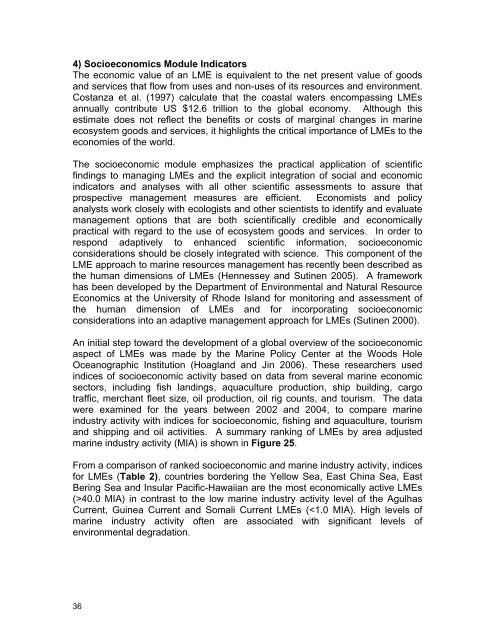Sustaining the World's Large Marine Ecosystems
Sustaining the World's Large Marine Ecosystems
Sustaining the World's Large Marine Ecosystems
You also want an ePaper? Increase the reach of your titles
YUMPU automatically turns print PDFs into web optimized ePapers that Google loves.
4) Socioeconomics Module Indicators<br />
The economic value of an LME is equivalent to <strong>the</strong> net present value of goods<br />
and services that flow from uses and non-uses of its resources and environment.<br />
Costanza et al. (1997) calculate that <strong>the</strong> coastal waters encompassing LMEs<br />
annually contribute US $12.6 trillion to <strong>the</strong> global economy. Although this<br />
estimate does not reflect <strong>the</strong> benefits or costs of marginal changes in marine<br />
ecosystem goods and services, it highlights <strong>the</strong> critical importance of LMEs to <strong>the</strong><br />
economies of <strong>the</strong> world.<br />
The socioeconomic module emphasizes <strong>the</strong> practical application of scientific<br />
findings to managing LMEs and <strong>the</strong> explicit integration of social and economic<br />
indicators and analyses with all o<strong>the</strong>r scientific assessments to assure that<br />
prospective management measures are efficient. Economists and policy<br />
analysts work closely with ecologists and o<strong>the</strong>r scientists to identify and evaluate<br />
management options that are both scientifically credible and economically<br />
practical with regard to <strong>the</strong> use of ecosystem goods and services. In order to<br />
respond adaptively to enhanced scientific information, socioeconomic<br />
considerations should be closely integrated with science. This component of <strong>the</strong><br />
LME approach to marine resources management has recently been described as<br />
<strong>the</strong> human dimensions of LMEs (Hennessey and Sutinen 2005). A framework<br />
has been developed by <strong>the</strong> Department of Environmental and Natural Resource<br />
Economics at <strong>the</strong> University of Rhode Island for monitoring and assessment of<br />
<strong>the</strong> human dimension of LMEs and for incorporating socioeconomic<br />
considerations into an adaptive management approach for LMEs (Sutinen 2000).<br />
An initial step toward <strong>the</strong> development of a global overview of <strong>the</strong> socioeconomic<br />
aspect of LMEs was made by <strong>the</strong> <strong>Marine</strong> Policy Center at <strong>the</strong> Woods Hole<br />
Oceanographic Institution (Hoagland and Jin 2006). These researchers used<br />
indices of socioeconomic activity based on data from several marine economic<br />
sectors, including fish landings, aquaculture production, ship building, cargo<br />
traffic, merchant fleet size, oil production, oil rig counts, and tourism. The data<br />
were examined for <strong>the</strong> years between 2002 and 2004, to compare marine<br />
industry activity with indices for socioeconomic, fishing and aquaculture, tourism<br />
and shipping and oil activities. A summary ranking of LMEs by area adjusted<br />
marine industry activity (MIA) is shown in Figure 25.<br />
From a comparison of ranked socioeconomic and marine industry activity, indices<br />
for LMEs (Table 2), countries bordering <strong>the</strong> Yellow Sea, East China Sea, East<br />
Bering Sea and Insular Pacific-Hawaiian are <strong>the</strong> most economically active LMEs<br />
(>40.0 MIA) in contrast to <strong>the</strong> low marine industry activity level of <strong>the</strong> Agulhas<br />
Current, Guinea Current and Somali Current LMEs (









